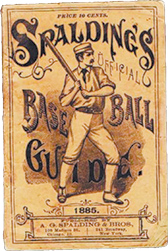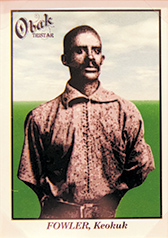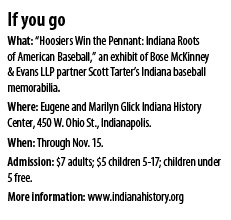Subscriber Benefit
As a subscriber you can listen to articles at work, in the car, or while you work out. Subscribe NowBaseball once was Indiana’s game, and attorney Scott Tarter has a major-league passion about preserving its rightful, if obscure, place in history.
“One of the things I love about this is telling people about it, and a lot of times they doubt me,” said Tarter, a partner at Bose McKinney & Evans LLP. But when remarkable tidbits about the national pastime’s Hoosier roots resurface, Tarter said a common reaction is, “How is it that more people don’t know about this?”
More people are discovering it thanks to Tarter’s efforts to seek out and preserve fading scraps of Indiana baseball lore. The Indiana Historical Society is exhibiting some of his collection in “Hoosiers Win the Pennant: Indiana Roots of American Baseball.”
Tarter has collected sports memorabilia since childhood, but in recent years his focus shifted to the early days of baseball in Indiana. What he discovered goes against conventional wisdom that the Hoosier state really isn’t much of a baseball haven.
“That’s kind of what fueled my fire,” Tarter said. “I was one of those people who believed that.”
But the tobacco and Cracker Jack baseball cards, scorecards, newspaper clippings and other artifacts he’s gathered tell another story. “How striking is it,” Tarter said, “that Indiana hosted the very first major-league baseball game?”
While baseball historians recognize the 1869 Cincinnati Red Stockings as the first professional baseball team, the National Association of Base Ball Players formed the first pro sports league in 1871. And on May 4 of that year, the Fort Wayne Kekiongas hosted what’s considered the first major-league baseball game, defeating the Cleveland Forest Citys 2-0.
 One of the first pro baseball guides. (Photo from the Tarter Family Collection)
One of the first pro baseball guides. (Photo from the Tarter Family Collection)The Kekiongas – a name inspired by the Miami tribe’s settlement at the confluence of Fort Wayne’s three rivers – lasted just one season. In the years that followed, though, numerous major-league teams played in Indianapolis during the era before baseball fielders wore gloves.
The Blues of the three-year-old National League called the city home in 1878. The Indianapolis Hoosiers played in the precursor to the American League in 1884, and another Hoosiers team was fielded in the National League from 1887 to 1889.
But the city’s greatest success on the diamond came in 1914, when the Hoofeds, Hoosiers of the Federal League, were crowned champions of the upstart rival to Major League Baseball. Two future Hall of Famers played in Indianapolis that championship season – third baseman William Boyd McKechnie and outfielder Edd Roush.
Attorney Craig Pinkus said Tarter’s collection has refreshed a hidden history. “The exciting part of the whole thing is he’s reintroducing people to a part of sports history that’s been lost for a while, and it’s significant,” Pinkus said.
Legal lessons
Pinkus and fellow Bose colleague Gary Roberts plan to present a continuing legal education program in connection with the exhibit that will look at pertinent issues of law relating to baseball. Pinkus will talk about intellectual property law, and Roberts will focus on the antitrust exemption that Major League Baseball has enjoyed for almost a century. Roberts is antitrust counsel to Minor League Baseball.
 A baseball card depicting Bud Fowler. (IL photo/Eric Learned)
A baseball card depicting Bud Fowler. (IL photo/Eric Learned)Their presentation will take place at the Eugene and Marilyn Glick Indiana History Center Nov. 5 from 8-11:30 a.m.
Tarter said that in a tangential way, the Hoofeds’ championship season can be linked to the legal protection that Major League Baseball enjoys. The Federal League folded a year after Indianapolis won the pennant, then filed an antitrust case, Federal Baseball Club v. National League, 259 U.S. 200 (1922).
Federal Judge Kenesaw Mountain Landis in Chicago tossed out a trial court verdict in favor of the Federal League, holding that antitrust laws didn’t apply to Major League Baseball. Landis would become the first commissioner of baseball in 1921, and the Supreme Court of the United States unanimously affirmed his opinion a year later.
Roberts said the antitrust exemption has been affirmed twice by the high court in decades since, most recently in the 1970s. “The court simply did not want to force the complete restructuring of the national pastime by judicial fiat,” he said.
The antitrust exemption recognizes the unique and important role of major- and minor-league baseball in society, Roberts said. Courts also have expressed concern about the uncertainty that could come without the exemption, he explained, and “a belief that the current structure of baseball is a good institution in our society, and why mess with it?”
 Pinkus will address a number of copyright, right-of-publicity and other intellectual property laws that can come into play for collectors. For instance, reproducing for commercial purposes the likeness of a player who died in 1915 might violate right of publicity that lasts for 100 years after someone has died, according to Indiana law.
Pinkus will address a number of copyright, right-of-publicity and other intellectual property laws that can come into play for collectors. For instance, reproducing for commercial purposes the likeness of a player who died in 1915 might violate right of publicity that lasts for 100 years after someone has died, according to Indiana law.
“There are so many old and famous trademarks associated with the game … and there are some surprising things, too,” Pinkus said. Notably, the Brooklyn Dodgers remains a registered mark almost 60 years after the team moved to Los Angeles. Even Fenway Park’s outfield wall known as the Green Monster is protected by trademark.
“Collectors at a convention who slap that wonderful Jackie Robinson image on T-shirts as a souvenir better know what you’re doing,” he said.
Fueling a fascination
For Tarter, collecting the earliest pieces documenting Indiana’s baseball past has yielded some amazing finds. The 1884 Hoosiers, for instance, hosted a Toledo Blue Stockings team with two African-American players – brothers Moses Fleetwood Walker and Weldy Walker – more than 50 years before Jackie Robinson broke the modern baseball color barrier.
Tarter also noted that the earliest-known African-American player in organized baseball, John “Bud” Fowler, whose playing days date to 1878, later played for teams in Indiana.
Tarter has found historical references to those players in his collection, along with some contemporary baseball cards recording their place in history.
“I actually applied legal research skills in order to do this, whether I’m searching online or antique stores or memorabilia dealers,” Tarter said of locating the rare items in his collection. “I keep an eye out for these gems that need to be preserved and made available to people.”
Because much of his collection is paper, he keeps those objects of ephemera in acid-free sleeves in temperature-controlled environments.
One such item is a letter that proves you don’t have to be an all-star to be part of baseball history. Jack Fanning wrote from Buffalo, Ind., describing his ignominious experience with the Indianapolis Hoosiers in 1889.
Tarter explained Fanning was promised $250 but paid only $50 after he pitched less than an inning for the Hoosiers because a catcher threw a hardball back to him that injured his hand.
“As a lawyer, it’s kind of interesting to hear him complaining about the ill treatment he received,” Tarter said.•
——————————————————————
Test your Indiana baseball trivia
1. The first recognized major-league baseball game in America was played in which of these cities?
A. Indianapolis
B. Evansville
C. Fort Wayne
D. Crawfordsville
2. One hundred years ago, an Indianapolis baseball team was crowned a major-league champion. What was the team’s nickname?
A. Hoosiers
B. Arrows
C. Blues
D. Hoofeds
3. Which of the following Hall of Famers played for the Negro American League’s Indianapolis Clowns?
A. Hank Aaron
B. Larry Doby
C. Josh Gibson
D. Willie Mays
4. In 1878, a National League team played at a ballpark at South and Delaware streets in Indianapolis. What was the team’s name?
A. Hoosiers
B. Whales
C. Blues
D. Aces
5. In 1908, the last time the Chicago Cubs won a World Series, Hoosier Mordecai Brown was the winning pitcher in two of the Cubs’ four victories over the Detroit Tigers. Which of these cities was Brown’s hometown?
A. Muncie
B. Nyesville
C. LaPorte
D. Wabash
Answers
C. The Fort Wayne Kekiongas hosted the first game of the National Association of Professional Base Ball Players on May 4, 1871, defeating the Cleveland Forest Citys 2-0.
D. The Hoofeds – Hoosiers of the Federal League – were the 1914 champions of the short-lived rival league that folded just before Major League Baseball was exempted from antitrust laws.
A. Hank Aaron played briefly in Indianapolis for the Clowns before his contract was sold to the Milwaukee Braves in 1952 for $10,000.
C. The Blues played at the South Street Grounds.
B. Mordecai Brown was born in Nyesville and lived most of his life in Terre Haute. He was posthumously inducted into the Hall of Fame in 1949.
Source: Scott Tarter, IL research
Please enable JavaScript to view this content.

